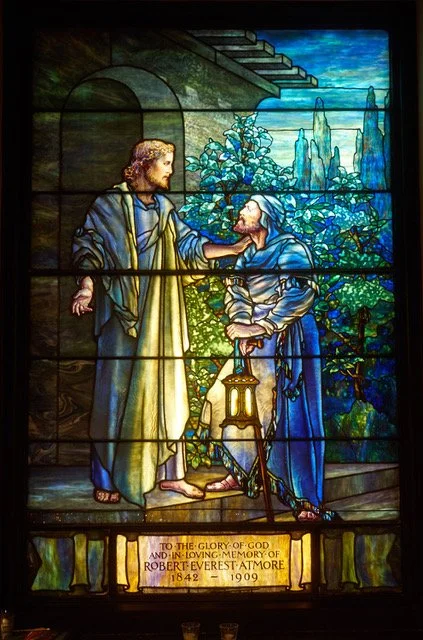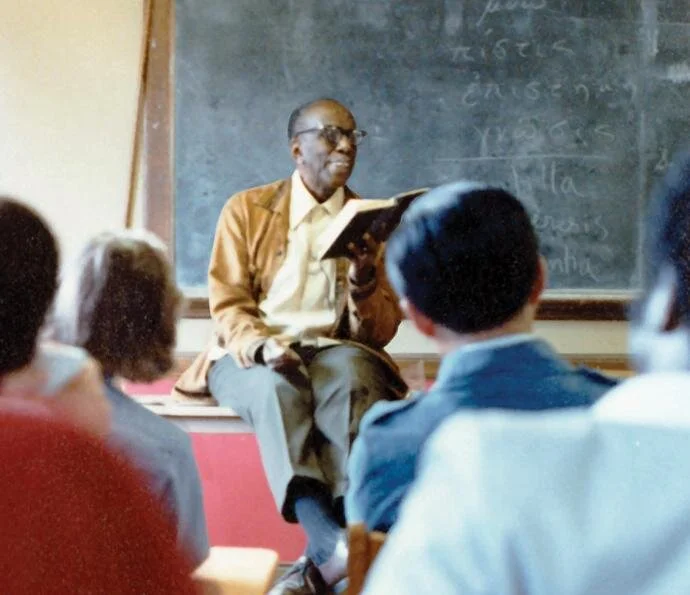How does St. Stephen speak for us? Part I
Father Peter and Suzanne will retreat from St. Stephen’s until September. In their absence, we’ll revisit some of their recent Reflections as springboards, or perhaps compasses, for much-needed broader reflections on any course forward. We begin with Suzanne’s foundational questions about this church, how it came to be associated with St. Stephen and how that first martyr/deacon speaks for us today.
Since we began work at this historic church, we’ve been asking why it was dedicated to St. Stephen. How does he, as our patron saint, speak for this community for almost 200 years? I’ll call him Stephen from here on (except in image captions) to distinguish him from his churches mentioned in the text (St. Stephen’s).
St. Stephen
Some public material from the 1980s-90s for our St. Stephen’s claims this Episcopal church honored the Gothic cathedral in Vienna, mother church of the Roman Catholic Archdiocese there with the same name.
Why? There are Gothic and Neo-Gothic churches that look more like ours (an architectural issue), that bear other names (an issue of message), within the Anglican Communion. Our consecration sermon applauded such Anglican churches as the ideals met in this new early American Neo-Gothic one. Where does Stephen fit in? The consecration sermon tells us nothing.
So what’s in a name? The many examples emphasize having to choose: Christian elements, geographic designations (like the 10th Street Episcopal Church), or today’s Ultra-Hipster possibilities (The Edge Church).
Names, websites on church branding insist, should convey meaning, especially for the choice of a model human to signal who the community is and what it does—identity and mission.
Today, we look for that message in Stephen in the first of two parts, this one focused on this church's first century. It’s timely. Reflecting on our given patron saint dives deep into the self-examination that religious institutions and St. Stephen’s, in particular, have undertaken over the last years. The pandemic has provided both a space and an urgent push to such re-evaluation. We’re in an accelerated process of Becoming, the very nature of Advent. To consider our community’s relationship to Stephen within this church season, which includes his feast day (December 26), seems uncannily right.
Who Was Stephen?
Stephen was a star, a pivotal player in the formation of the Church, foregrounded in Luke’s account of that process in Acts (Acts 6-7). He was also the formidable voice that publicly presented, before the highest Jewish council (the Sanhedrin), the doctrinal foundation of the Church, an act of bearing witness that precipitated his death.
To judge by his Greek name, Stephen was a Hellenistic Jew in a diverse community dominated by Hebrew Jews. Scholars give his dates as 5 AD to 34 AD, meaning he was born after Christ’s death, and acted and died in his 20s. He was in Jerusalem as the number of followers of Christ’s teaching exploded to the point that the Twelve (Apostles) felt they could not preach, pray, and serve their community. When Hellenistic Jews complained that their needy widows were neglected in the group’s charitable services, the Twelve ordered them to choose seven among them to attend to this business, who must be “of honest report, full of the Holy Ghost and wisdom [Acts 6: 3].” The first appointed was Stephen.
The youth not only met the Twelve’s requirements; he was extraordinarily multi-faceted. He was already full of the faith and power, performing miracles and wonders. He was open, committed, and admired for his character and wisdom. Unlike the humble Apostles, Stephen was highly educated, a top student of the top Jewish law professor, Gamaliel, a force on the Sanhedrin. Stephen’s judgment and trained intelligence masterfully engaged with the conceptual and the practical. He was a riveting, transformative preacher as well as effective administrator. He was also a peacemaker in his quarrelsome world.
The excellent Stephen inevitably posed a threat to some. He was brought before the Sanhedrin, falsely accused of blasphemy against Moses and God, and of announcing the destruction of Solomon’s Temple.
In a brilliant and forceful defense—its importance to Luke signaled by his making it the longest in Acts—Stephen refuted charges by arguing that his group followed Christ as the fulfillment of all prophecies since Abraham. The group also respected all covenants since Abraham as the assembled judges and their fathers failed to do. His group, he contended, posed no threat to the Temple since, according to the prophet they all purportedly heeded, God stated he was in no one or manmade place, only in those he himself made—everywhere. Stephen berated his judges for violating God’s word by insisting on a single sacred place and manmade building as God’s house (Solomon’s Temple). While arguing, the youth became radiant as he reported a vision of the risen Christ standing to the right of God in support of his defense. Unable to respond to his arguments and offended by his rebuke and sacrilegious vision during questioning, a furious contingent removed him and had him stoned to death outside a city gate. Stephen sacrificed diplomacy and his life to bear witness.
As he died, Stephen echoed Christ’s plea for forgiveness of his executioners.
This first Christian martyrdom after Christ’s opens a pivotal new chapter in Church history. Standing by Stephen’s clothing, as witness and reported supporter of the execution, was Saul of Tarsus, a fierce persecutor of Christ’s followers. Saul was another of Gamaliel’s gifted students whose subsequent conversion to Christianity with the name of Paul transformed him into one of the foremost Christian missionaries and martyrs. Perceiving Stephen’s death as escalated persecution, the Apostles scattered, spreading the Word and Church, fulfilling Christ’s command to bear witness throughout the world.
Stephen himself became an unusually wide-ranging model and symbol. His martyrdom was the first of the newborn Church, a cornerstone for an entity reinforced over centuries by acts of borne witness. As the leading inaugural deacon of the Church, he came to embody the earthly Church and its commitment to service within a diverse community. As a compelling orator, he became one of Christianity’s most brilliant evangelists and apologists. He prefigures the Church Fathers for his learned perspective on doctrine and Christianity’s deep history and future only a few years after Christ’s life and seminal impact.
Why did a 19th-century Episcopal Church Choose Stephen?
What little we know comes from the bishop who ritually founded St. Stephen’s: the Bishop of Pennsylvania, The Right Rev. William White. His report of his year’s activities to the Diocesan Convention in 1823 tells us that, on May 30, 1822, he laid the cornerstone for a church in Philadelphia named after “the first martyr, St. Stephen.”
Honoring the first martyr seems an easy way to link the New (an American Protestant church) to Christianity’s foundations through the familiar fatal act of bearing witness. Yet there are subtleties to consider.
St. Stephen’s was hardly the first American church; there were many from the colonial period, even Anglican churches just in Philadelphia that became Episcopal ones, like Christ Church. Nor was it the first “native” Episcopal church or even the first St. Stephen’s Episcopal Church in the Diocese. That last honor apparently goes to a church in Wilkes-Barre, founded in 1817 as the town became a booming city, thanks to the revolutionary new fuel source found there, anthracite coal.
Fra Angelico, Lives of St. Stephen [top] and St. Lawrence [bottom], 1447/9, fresco; Niccoline Chapel, Vatican
So what did Stephen have to say in Philadelphia in 1823? I have several proposals that distinguish this new church from others. I’ll start by considering a precedent at the Vatican in the 15th c.
These monumental frescoes illustrate episodes from the lives of Stephen and the later Lawrence (225 AD-258 AD), martyred deacons from different times and places (Jerusalem and Rome). The frescoes decorate the private chapel of Pope Nicolas V (1397-1455), for whom they defined the Church’s ongoing mission under his papacy: to care for the needy of a burgeoning Rome, to further Christianize its population, and to engage with Church doctrines under test through time and circumstance. Stephen appears in several activities: serving (right half of the detail illustrated here), enthralling his audience while preaching, and engaging with the Sanhedrin (both in the general view).
Detail: Fra Angelico, Consecration of St. Stephen [left] and St. Stephen Serving the Needy [right]
In representing 1st-c. Jerusalem and 3rd c. Rome within a 15th-c. Vatican project, the frescoes emphasize the spread of the Church and Word into the Pope’s own time from the Holy Land throughout Europe, with all the attendant developments in church hierarchy, administration, architecture, rituals, and vestments.
Change. Becoming.
Stephen’s criticism of manmade houses for God is eclipsed by the many churches built around the globe (including in his honor!) that at least acknowledged divine presence everywhere. These frescoes celebrate those changes through their details yet provide a touchstone of constancy in their subjects.
Stephen could provide a similar touchstone in early 19th-c. Philadelphia under energetic development. It was now full of Episcopal churches that marked the continuing spread of Christianity through ever-more denominations. Who better than this wise “cornerstone” of Christianity to rise, in the form of the problematic manmade church, in the midst of so many others?
There’s more. As the first Christian deacon, Stephen personifies the Episcopal Church itself. Its very name, Episcopal (from “bishop”) affirms the Church’s social structure and activities as established by the Apostles themselves. The Church’s subsequent development has triggered bitter debate since the Protestant Reformation, branches of which sought the worshipper’s direct connection with God without clerical mediation. Stephen reconciled those points too. He was that exemplary Christian with a direct connection to God (full of the spirit, visions) who acted admirably within the evolving Church.
Philadelphia’s new St. Stephen’s Episcopal Church also offered a distinct vision of Christianity for modern Americans through its High-Church mix of catholic [early universal] tradition and Protestant reformation devised by its consecrating bishop, the Bishop of New York, The Right Rev. John H. Hobart (1775-1830). His concept gave special emphasis to the sacraments, ritual, clergy, and a movingly beautiful church (sorry, Stephen). In embracing Hobart’s approach, St. Stephen’s specialized. Like others founded at the time, it spun off from Bishop White’s tolerant blend of High and Low clergy within his own Philadelphia churches (notably Christ Church). Philadelphia’s new St. Stephen’s thus distinguished itself from its Low-Church neighbors, the older St. Paul’s and the newest (a few months younger), St. Andrew’s a couple of blocks east.
Architecturally and in worship, St. Stephen’s invoked the Middle Ages, offending Protestant adherents who condemned the approach as corrupt Romanism. But St. Stephen’s insisted on its adherence to the primitive Church through its patron saint, Stephen, who powerfully embodied that founding model and the ageless covenants that, he affirmed, guided them into the future.
All camps sought to recapture the primitive Church in modern doctrine and worship. They disagreed on how, leading to increasingly bitter disputes for decades. One of the most critical was a showdown over Hobart’s legacy, Oxford Tractarianism, in the 1844 General Convention in Philadelphia. Filling the role of the peacemaker Stephen repeatedly was St. Stephen’s second rector, The Rev. William H. Ducachet.
Unknown designer and maker, Stephen and Paul, by 1880
Stephen’s later messages at St. Stephen’s
The first actual representation of Stephen that I’ve found at St. Stephen’s marks another pivotal chapter in the church’s history that he “speaks for.” He appears in a double memorial window installed around 1880 in a new addition to the church, Frank Furness’ transept to the north completed in 1878.
Stephen appears with Paul, as some have suggested, though they are made similar in age and dress, downplaying Stephen’s guise as deacon. Identified by stones at his feet, Stephen stands with Paul (book and sword) as missionaries of the Word for which each died. The book is our clue. Both, as I indicated earlier, were reportedly Gamaliel’s top students, gifted orators and, in Paul’s case, a writer. So the window, I suggest, subtly celebrates their vital role in spreading the Word and the Church.
General view of the 1878 transept in 2018
Especially given its location in the new transept, this subject also applauds St. Stephen’s impressive growth since 1823, thanks to its third rector, The Rev. William Rudder, who, like Stephen, was a celebrated orator. His sermons drew a great number of new people who joined the congregation and added to its activities. To accommodate the growth, the transept provided more public worship space and a new vestry room managed the increased administrative demands.
From his window within Furness’ new transept, Stephen, lauded preacher of the primitive Church, presides over a growing congregation drawn to the Word conveyed and interpreted by his modern successor.
The window also addresses a bittersweet consequence of St. Stephen’s enlargement to this point. It commemorates a distinguished shipping magnate and his wife who died much earlier (1833 and 1854), whose vault in the original cemetery was covered by Furness’ addition.Their daughter contributed the window to compensate for the tomb’s disappearance from view under the new transept. Ann Griffith Coleman’s window honoring Stephen and Paul, signal forces in the Church’s first growth, becomes a dignified tribute to the newest expansion that overtook her parents’ resting place.
Change. Becoming.
—Suzanne Glover Lindsay, St. Stephen’s historian and curator









